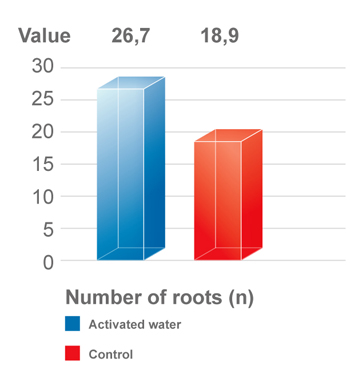Influence of OET in plants
OET in plants – scientific evidence of increased root formation in plant seedlings: Effect of OET on the adventitious root formation of mung beans (Vigna radiata (L.) Wilczek) and cress (Lepidium sativum)
Institute for Agricultural and Urban Ecological Projects
at the Humboldt University in Berlin Invalidenstraße 42, 10115 Berlin, Germany
Project manager: Dr. Rafael Valbuena
Scientific team:
Dipl.-Ing. Karen Sensel
Dr. Amarilis Suarez
Summary
Activated water produced with the OET-5 device (activated air) had a tendency to influence adventitious root formation in mung beans and garden cress in a positive manner. This positive effect was demonstrated in test 2 in a statistically significant manner.
Introduction
Numerous effects resulting from the use activated water are reported. The aim of the tests was to employ biological test methods to investigate whether air activated with the Active Air device and supplied through water can influence adventitious root formation and germination in mung beans (Vigna radiata (L) Wilczek) and garden cress (Lepudium sativum).
Tests conducted:
Materials
Plants
Mung beans and garden cress were selected for examining adventitious root formation. The mung bean (Vigna radiata (L) Wilczek), also known by a variety of other names including green gram and moong bean, is an economically useful plant belonging to the pulse family. Garden cress (Lepidium sativum) is an annual herbaceous plant growing up to 50 centimetres in height.
Substrate
Vermiculite was used as the substrate for the tests with mung beans.
Aqueous test solution
Demineralised water: The water was demineralised with an ion exchanger.
Distilled water: The water was demineralised and then distilled.
Activated water: Depending upon the control group (demineralised or distilled water), demineralised or distilled water was activated with an OET-5 (former Active Air® 5) device from Medical Biophysics® GmbH shortly before being used. For this, activated air from the Active Air® 5 device was fed into 500 ml of the particular water for 30 minutes, thus activating it. The activated water was stored in a special violet glass bottle until needed.
Tests:
Test 1: Influence of activated water on the germination of mung beans
Test 2: Influence of activated water on adventitious root formation in mung beans
Results:
Test 1: After being kept in the dark for 24 hours the mung bean seeds had all begun germinating. No difference in germination rate could be observed between the seeds treated with activated water and those treated with distilled water as all 100 seeds from each group had germinated.

